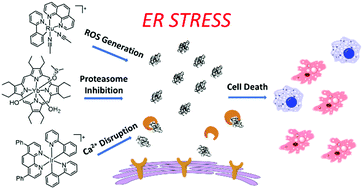Endoplasmic reticulum stress: an arising target for metal-based anticancer agents
Abstract
The endoplasmic reticulum (ER) has recently emerged as a promising target for anticancer agents. Cytotoxic compounds that target the ER often exhibit selectivity for cancer cells over non-cancer cells. Furthermore, the induction of ER stress often leads to immunogenic cell death, providing another factor that contributes to the clinical efficacy of drugs that target this organelle. Among potential ER stress-inducing agents, metal complexes, which possess redox activity and modular structures, have arisen as promising candidates. In the last two decades, dozens of metal complexes have been reported that kill cancer cells via ER stress induction, and many of these complexes exhibit nanomolar activity in vitro as well as powerful tumor inhibition in vivo. In this review, we summarize the current state of investigations on the ER stress-inducing properties of metal complexes. This review starts with a description of the ER, its function, and its role in cancer progression and treatment. Following this discussion, a guide to experimental methods that can be used by researchers to detect ER stress is provided. The majority of this review summarizes previous studies on metal-based anticancer agents that cause ER stress. Finally, a discussion on the perspectives and significance of using metal complexes as ER stress-inducing agents for the treatment of cancer is provided, along with a summary of structural trends that contribute to this type of biological activity.

- This article is part of the themed collection: 2020 Emerging Investigators


 Please wait while we load your content...
Please wait while we load your content...
